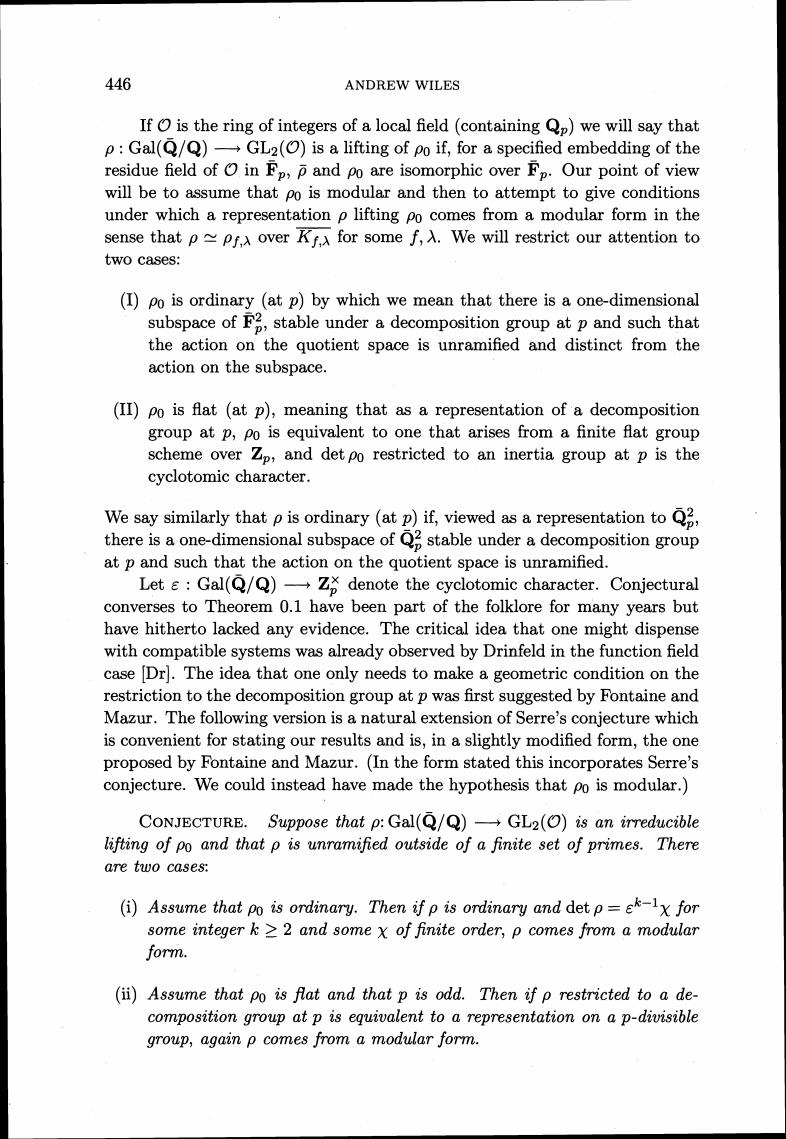正在加载图片...

446 ANDREW WILES If is the ring of integers of a local field(containing Qp)we will say that Gal(Q/Q)-GL2()is a lifting of po if,for a specified embedding of the residue field morphic over Fp.Our point of view will be to assume that po is modular and then to attempt to give conditions under which a representation p lifting po comes from a modular form in the sense for some f,.We will restrict our attention to two cases: (I)po is ordinary (at p)by which we mean that there is a one-dimensional subspace of F2,stable under a decomposition group at p and such that the action on the quotient space is unramified and distinct from the action on the subspace. (II)Po is flat (at p),meaning that as a representation of a decomposition group at p,po is equivalent to one that arises from a finite flat group scheme over Zp,and det po restricted to an inertia group at p is the cyclotomic character. We say similarly that p is ordinary(at p)if,viewed as a representation to Q? there is a one-dimensional subspace of Q2 stable under a decomposition group at p and such that the action on the quotient space is unramified. Let e:Gal(Q/Q)Z denote the cyclotomic character.Conjectural converses toTheorem0.1 have been part of the folklore for many years but have hitherto lacked any evidence.The critical idea that one might dispense with compatible systems was already observed by Drinfeld in the function field case [Dr).The idea that one only needs to make a geometric condition on the restriction to the decomposition group at p was first suggested by Fontaine and Mazur.The following version is a natural extension of serre's coniecture which is convenient for stating ou r results and is,in a slightly modified form,the one proposed by Fontaine and Mazur.(In the form stated this incorporates Serre's conjecture.We could instead have made the hypothesis that po is modular.) CONJECTURE.Suppose that p:Gal(Q/Q)-GL2(O)is an irreducible lifting of po and that p is unramified outside of a finite set of primes.There are two cases (i)Assume that po is ordinary.Then if p is ordinary and det p=ek-1x for some integer k >2 and some x of finite order,p comes from a modular form. (ii)Assume that po is flat and that p is odd.Then if p restricted to a de- composition group at p is equivalent to a representation on a p-divisible group,again p comes from a modular form. 446 ANDREW WILES If O is the ring of integers of a local field (containing Q,) we will say that p : Gal(Q/Q) -GL2(0) is a lifting of po if, for a specified embedding of the residue field of O in F, p and po are isomorphic over F,. Our point of view will be to assume that po is modular and then to attempt to give conditions under which a representation - p lifting po comes from a modular form in the sense that p - pf,~over Kf,xfor some f, A. We will restrict our attention to two cases: (I) po is ordinary (at p) by which we mean that there is a one-dimensional subspace of F;, stable under a decomposition group at p and such that the action on the quotient space is unramified and distinct from the action on the subspace. (11) po is flat (at p), meaning that as a representation of a decomposition group at p, po is equivalent to one that arises from a finite flat group scheme over Z, and det po restricted to an inertia group at p is the cyclotomic character. We say similarly that p is ordinary (at p) if, viewed as a representation to QE, there is a one-dimensional subspace of Q; stable under a decomposition group at p and such that the action on the quotient space is unramified. Let E : Gal(Q/Q) -+ Z: denote the cyclotomic character. Conjectural converses to Theorem 0.1 have been part of the folklore for many years but have hitherto lacked any evidence. The critical idea that one might dispense with compatible systems was already observed by Drinfeld in the function field case [Dr]. The idea that one only needs to make a geometric condition on the restriction to the decomposition group at p was first suggested by Fontaine and Mazur. The following version is a natural extension of Serre's conjecture which is convenient for stating our results and is, in a slightly modified form, the one proposed by Fontaine and Mazur. (In the form stated this incorporates Serre's conjecture. We could instead have made the hypothesis that po is modular.) CONJECTURE.Suppose that p: Gal(Q/Q) -+GL2(C3) is an irreducible lifting of po and that p is unramified outside of a finite set of primes. There are two cases: (i) Assume that po is ordinary. Then if p is ordinary and det p = &"IX for some integer k 2 2 and some x of finite order, p comes from a modular form. (ii) Assume that po is flat and that p is odd. Then if p restricted to a decomposition group at p is equivalent to a representation on a p-divisible group, again p comes from a modular form